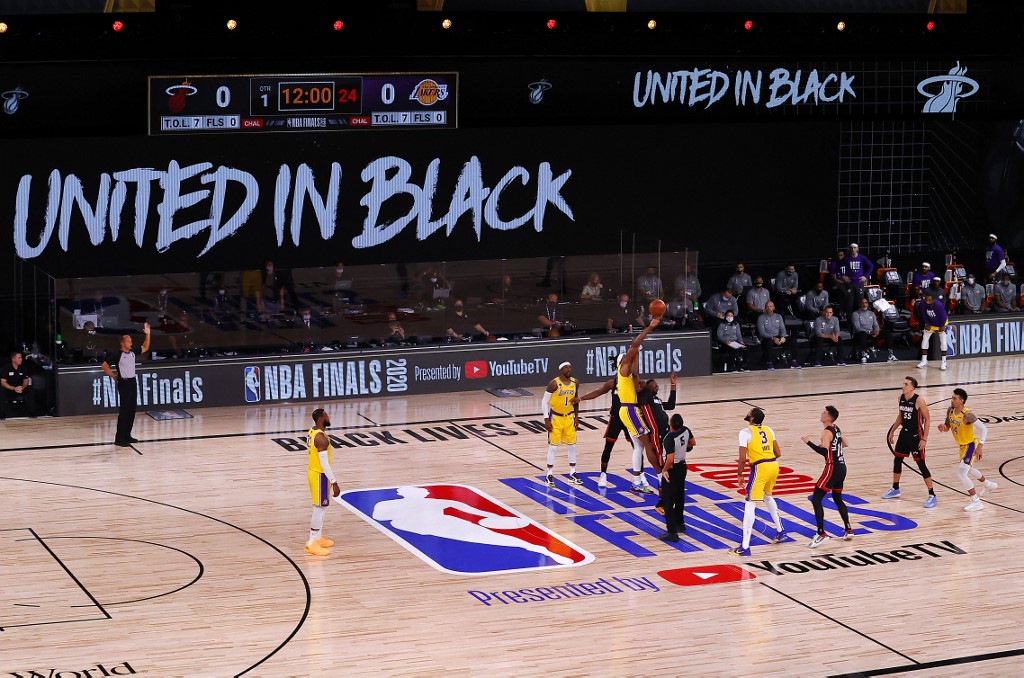
FILE — Tip-off between the Los Angeles Lakers and the Miami Heat during the first quarter in Game Four of the 2020 NBA Finals on October 6, 2020 in Lake Buena Vista, Florida. Kevin C. Cox/Getty Images/AFP
Television viewing figures for the NBA Finals have fallen to record lows but the slump is part of a broader trend caused by a sporting calendar thrown into chaos by COVID-19, industry analysts say.
While LeBron James and Jimmy Butler have served up a series of high-quality performances through the first four games of the finals, the basketball showpiece has failed to capture its usual US television audience.
Game one of the finals last Wednesday was watched by 7.41 million people according to figures on the Sports Media Watch website, compared to 13.4 million viewers for 2019’s game one in late May.
Game two last Friday fell to 6.61 million while game three tumbled further to 5.94 million, the lowest total ever recorded for an NBA Finals game.
Critics of the NBA claim the fall-off in viewers is attributable to the league’s decision to place social justice issues in the forefront of the sport since it resumed in Orlando in July.
“The NBA is engaged in a concerted effort to (1) insult their fans & (2) turn every game into a left-wing political lecture,” Republican Senator Ted Cruz wrote in a comment on Twitter, using the hashtag “GoWokeGoBroke” in a separate post.
Yet linking the TV viewing slump to the NBA’s embrace of the “Black Lives Matter” movement ignores multiple, unprecedented factors suspected of affecting viewing figures across all US sports.
With the COVID-19 pandemic sending sport in North America into a shutdown in March, the NBA was only able to return in July — a month after the season traditionally winds up in June.
That has left basketball in the unaccustomed position of jostling for attention against the NFL, far and away the most popular televised sport in the United States, as well as the climax of the baseball season.
Diminished spectacle?
Game one of this year’s finals clashed with Major League Baseball playoff games involving the Los Angeles Dodgers as well as the New York Yankees, drawing viewers from the two biggest media markets in the United States.
Game three of the finals went head-to-head with the NFL’s traditional “Sunday Night Football”, a staple of weekend sports television in the US.
“Going up head-to-head with the NFL and MLB post-season is a first, and the competition has had a negative effect on audience delivery,” media consultant Brad Adgate told the Front Office Sports website.
The NBA Finals are also taking place in subdued fan-free arenas, diminishing the sense of spectacle for television audiences.
Fierce competition from the news cycle — the finals are being held just weeks away from the November 3 US presidential election — is another drain on ratings, experts argue.
“It represents a highly fractionalized environment that is atypical for the NBA to air their finals in, against some pretty steep competition,” Patrick Crakes, a media consultant and former Fox Sports executive told AFP.
Crakes is skeptical that politics is driving the declining NBA viewing figures.
“I know people want to read politics into this,” he said. “There may be something to it, but I’d need a clean environment to make that call.”
The theory that politics is behind the NBA slump is also undermined by consistent declines across other sporting events forced to reschedule because of the coronavirus pandemic.
Ice hockey’s Stanley Cup Final average viewing figures fell by around 61%, while the US Open golf championship’s final round tumbled 56% to an all-time low.
Both US horse racing classics, the Kentucky Derby and Preakness, also registered sharp drops, tumbling 43% and 31% respectively, as well as motorsport’s Indianapolis 500, which fell 32% to an all-time low.
Crakes, meanwhile, believes that viewing numbers will bounce back next year, once the sporting calendar returns to its usual schedule.
“I would expect things to reset somewhere back to normal next year,” he said.
“I don’t think this is a permanent condition.”